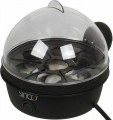—
Rotary switches. This type usually refers to electromechanical control — rotary knobs directly affect the corresponding elements of the steamer, without additional control schemes. This option is very simple and inexpensive, but the control options are quite modest and usually limited to the most basic functions. Therefore, it is mainly used in entry-level models.
—
Pushbutton switches. Control of the electronic type, carried out through specialized schemes. The cost of this option is higher than rotary switches, however, the possibilities are incomparably wider. In particular, the steamer can be equipped with automatic cooking programs and an extended set of timers (at the same time, the accuracy of setting the time will be very high), as well as various additional settings.
—
Sensory. Control, in many respects similar to the push-button (see above) — in particular, the set of features is also very extensive. However, it is based on sensors. The key difference is that the sensor does not need to be pressed unlike a button — it is activated by touch, which is very convenient. In addition, touch panels have a futuristic appearance and a smooth surface that makes cleaning much easier. On the other hand, such equipment significantly affects the price of a steamer.

